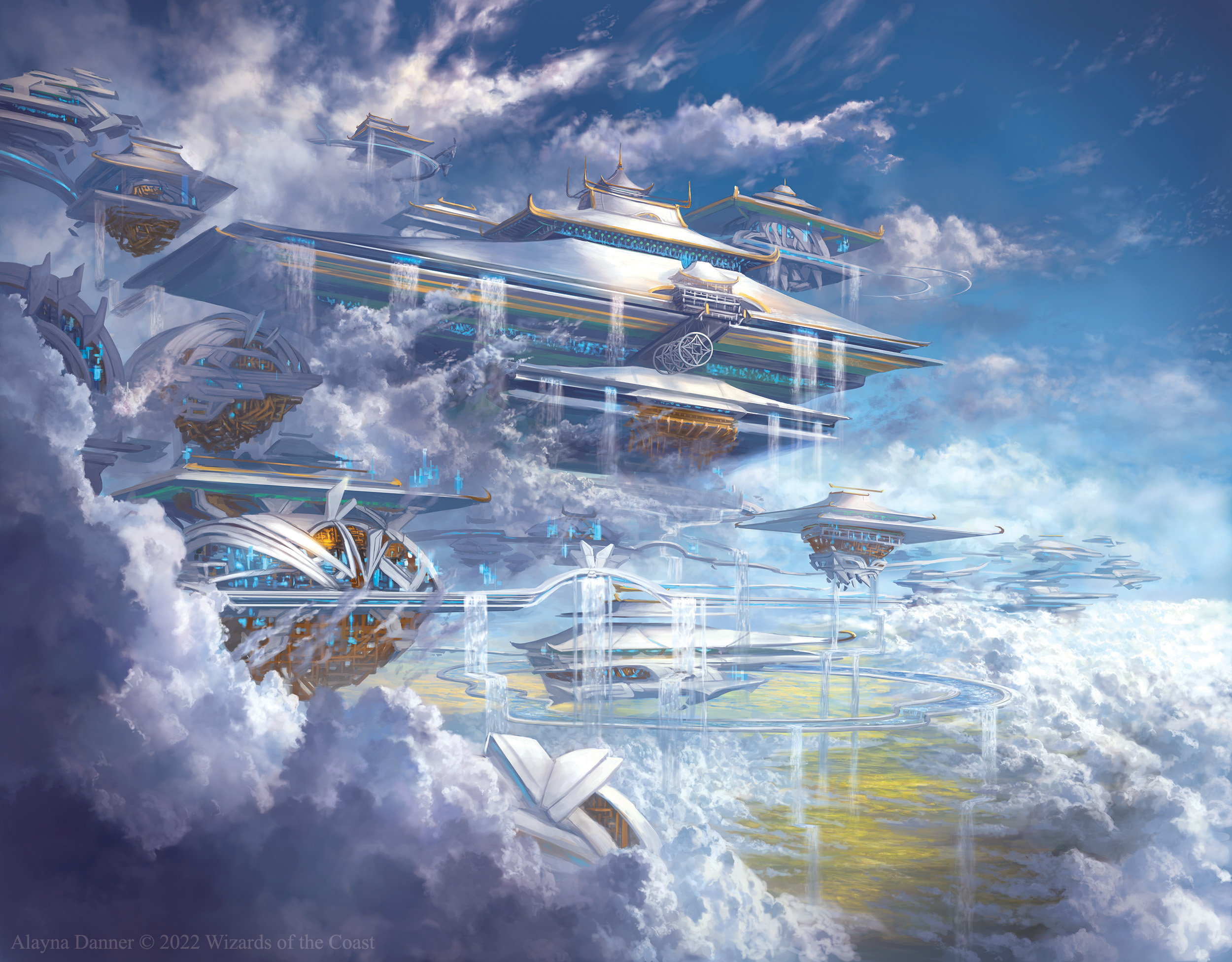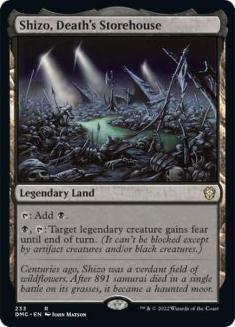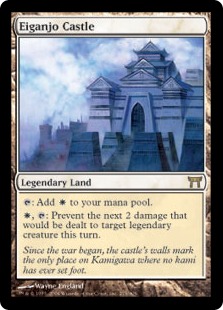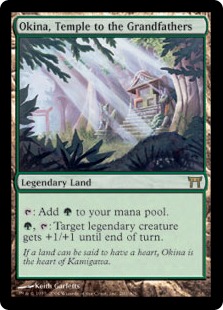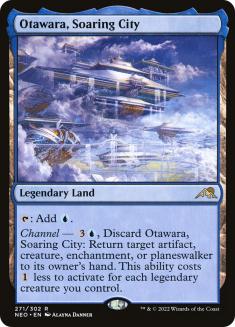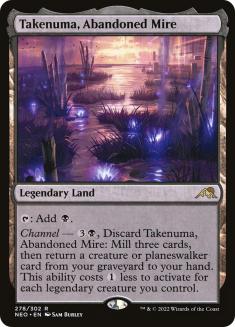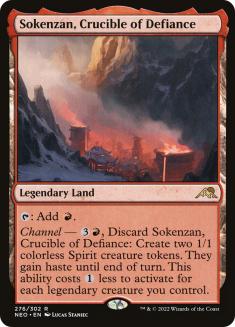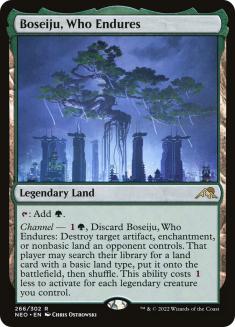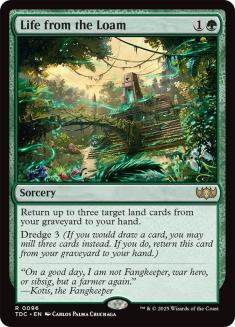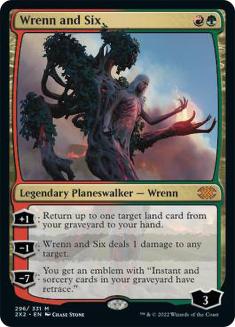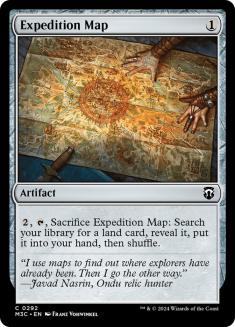Basic lands are the standard by which every other land is measured. Almost every time, if a land is better than a basic land, it will have a drawback to make up for it — it’ll enter the battlefield tapped, it’ll deal you damage, or it will require another payment of some sort. Lands that are strictly better than basic lands are not very common, and they’re usually quite good, because having extra abilities is more important than having the basic supertype.
Throughout history, we’ve seen a type of land that is strictly better than basic lands, with one caveat — they’re legendary. This means that the first of these lands is much better than a basic, but the second one is much worse. This creates a scenario in which almost everyone wants to play one of those, but the second, third, and fourth copies are up for debate.
With the original Kamigawa lands, the norm was to play one copy. They were often very powerful (especially Shizo, Death’s Storehouse, which could randomly be game-winning), but the drawback of drawing two copies was enough to deter people from playing more than one. It hasn’t always been this case, though; I remember that for a very long time I played two copies of Pendelhaven in my Dimir Faeries deck, for example, and that was a deck that could not even use green mana!
With Kamigawa: Neon Dynasty, we have a new batch of legendary lands!
The new channel lands might be similar in theme to the original Kamigawa lands, but that’s about where the similarity ends, because they behave very differently once you put them in a deck. The original lands were cards that acted as both lands and spells, and there was no use for an extra copy; these lands act as either lands or spells, and you can get rid of extra copies by simply using their channel ability. Because of this, we cannot draw on the heuristics of past Kamigawa lands to assess whether we want to play these lands and in which numbers. Instead, we should look more in the direction of the modal double-faced cards (DFCs) we currently have in Standard, because their play pattern will be almost the same.
In the end, this is just the new batch of Jwari Disruptions and Shatterskull Smashings, except the drawback is to be legendary rather than entering the battlefield tapped or losing life. This is a much better drawback to have in small numbers (where it’s not a drawback at all) and a potentially much bigger drawback in larger numbers.
One difference that could be key for certain decks is that, unlike the modal DFCs, they are lands on the front side, which means they can be recurred by cards like Life from the Loam and Wrenn and Six, and also that they are tutorable by Expedition Map and the like. This won’t be a big thing in the Arena formats because there’s not that much that interacts with nonbasic lands, but it’s definitely major in older formats and could also come up in new ones.
My first instinct is that, if you can afford the nonbasics, you definitely want to play at least one copy of these cards in every single deck. Nowadays, most decks can afford the slots. Here are the potential reasons you might not:
- Your deck is very heavily multicolored and you need to play a lot of multicolored lands. The first basic land might be better than the first legendary land because of Field of Ruin, for example.
- You need a number of basic lands to fetch. This usually happens with green ramp decks, such as Sultai Ramp (Yorion) last year, which wanted at least seven basics most of the time to make sure it could fetch all its colors.
- You need snow lands. Faceless Haven was the biggest culprit here, but it’s now banned in Standard and nerfed in Alchemy and Historic, so it’s not likely to be a big limitation. If your snow-based card is Blood on the Snow, then I think it’s fine to play some nonsnow lands.
- You have another card that cares about basic land types. Think of cards like Thirst for Discovery.
Outside of that, you should almost always play at least one of those. This means your Orzhov deck wants at least one Eiganjo and one Takenuma, your Izzet deck wants at least one Sokenzan and one Otawara, your Mono-Green deck wants at least one Boseiju, and so on.
Now, what about the second copy, or potentially the third and fourth? I think that will depend on the land, your deck, and the format. Something like Boseiju, Who Endures, for example, seems like a good one-of just in case, but a strong two-of (or potentially even three-of) if there are multiple artifacts and enchantments worth killing. When we rank the lands, we’re also going to talk about how many you’re likely to play in each deck.
The Legendary Clause
All five of the new lands also have a clause that says, “this costs 1 less for each legendary creature you control.” Honestly, I’m not sure why this clause exists, as it seems like it won’t come up often and you’ll easily forget when it does come up (on both sides). Sometimes you’re going to think, “They can’t have anything here,” and they’ll produce a surprise discount channel effect because you didn’t realize what was going on.
It’s also not like the cards needed more complexity. They’re already modal effects on legendary lands, which is definitely complex (and interesting) enough. The only explanation I can find is that they thought Ragavan needed more help in older formats.
Regardless, this clause does exist. Should it impact your deckbuilding in any way? Most of the time, no. They definitely get better in your Mox Amber, Bard Class, or Kethis, the Hidden Hand deck, but overall I would say that this is mostly trinket text that sometimes will come up as a bonus — as long as you remember that it’s there in the first place! I’m just happy mana burn is no longer a thing, because I’m sure I will overpay for these at some point in the future.
Now, let’s rank them!
5. Takenuma, Abandoned Mire
I will say that, as a cycle, these lands are all surprisingly close. Most of the time you have some that are clearly worse, but here I think they can all see a reasonable amount of play. That said, one of them has to be the worst, and I think that’s Takenuma, Abandoned Mire because it’s the one where you’re not getting an immediate effect. These cards are all overcosted by default, but they all do something, and here you’re getting something overcosted that doesn’t impact the battlefield at all, which makes things more awkward.
I think the right number of Takenuma, Abandoned Mire is probably one in very aggro black decks and two in the control decks. The effect is simply too expensive for aggro, and you’re unlikely to have something great to recur anyway, so it’s probably not worth the risk of drawing two copies and being unable to cast your spells; it’s much better to have Agadeem’s Awakening for that effect. For control, though, the games will be long and drawn-out, so you will have the chance to recur cards like Lolth, Spider Queen, and you will have the time to recast them and they will actually matter, so I think two copies are good.
4. Sokenzan, Crucible of Defiance
Sokenzan, Crucible of Defiance is sort of a creature-land, except it’s an instant and has haste, so it can catch your opponent off-guard in two different ways. Overall, I believe this has the weakest effect of all the cards in a vacuum, but it’s also the least situational one; every other one demands something, which means you could be stranded with them in your hand, but this is a card you can always use if you have the mana, so extra copies will never be dead, which means this might see play in higher numbers than the others, even though the effect is worse.
On top of that, by being an aggressive card, it’s the most likely to get the discount, as you’re most likely to have a legend on the battlefield. If you’re playing a Boros deck, for example, you could follow up a Turn 2 Thalia with a Turn 3 Sokenzan.
In Standard, I think this card is a two-of in aggressive red decks and a one-of in control decks. If I’m playing a red control deck, like the late Izzet builds, I might be interested in channeling this at some point, but not enough to risk drawing the second copy in a deck that regularly wants ten lands on the battlefied. For an aggro deck, you’re usually going to stop at four or five lands, so at that point you just channel it and call it a day.
I think that, for Standard and Alchemy, this is the worst of the new lands because it competes unfavorably with Den of the Bugbear most of the time. However, it might be a powerful card in Historic, where it produces two instant-speed bodies for Indomitable Creativity, which can be huge for that deck. So, because of the potential in Historic, I’m giving it fourth place instead of fifth.
3. Eiganjo, Seat of the Empire
Eiganjo, Seat of the Empire is a pretty solid card, though it is situational — they have to have creatures for it to matter, and it can’t be any creature. This is best in a control deck, but the aggro decks might be interested in removing a blocker or something that is racing them, though they can only remove the blocker after it blocks. White aggro decks might have a relatively easier time than most with the discount here, which is nice.
Overall, I think the right number of Eiganjos is two in aggro and two or three in control, depending on what the format looks like and how many instants you have. This card is easy to play around, so you can’t be in a spot where you leave mana open, they don’t attack and you lose your entire turn, especially against stuff like Werewolves. Assuming you have some extra instants to play, I’d start with three and then move down to two depending on how the format reacted to it. Importantly, though, I would not count all three as lands; if you’re going to play one or two, I think you can just make the swap and keep the same number of lands, but the third and fourth you need to treat as spells.
2. Otawara, Soaring City
Otawara, Soaring City is an overcosted card for sure (they all are), but the effect can be very strong in the right scenario, as this can bounce any permanent that’s not a land but including creature-lands! I wonder how scared of creature-lands R&D was to spell out each permanent type here rather than just writing “nonland” here. A lot of the time I play a blue deck, my opponent has a troublesome permanent on the battlefield and I’m in a race to get rid of it (such as a planeswalker that’s about to ultimate). Having that functionality in a land is awesome, especially now that Divide by Zero is either nerfed or banned.
I would say that the control decks (in all formats) probably want two of this card; it’s going to come up enough to justify the times you draw two copies. Aggro decks will want even more — three or potentially four copies. Such an aggro deck does not exist right now, but we’ve had examples before — things like Mono-Blue Aggro would have killed for a land that could also bounce something, Dimir Rogues would have wanted it, and don’t forget that Delver of Secrets is still legal, so this deck could definitely make an appearance. At the latest World Championship, for example, a player submitted an Azorius Aggro deck where this card would have been very good.
If such a deck plays cheap legends, then that’s also going to be huge for Otawara, as I feel this is where the discount matters the most of all the lands because it allows you to double-spell at a time where it matters the most. If there is a blue-based aggro deck, this will probably be the best of them in Standard.
1. Boseiju, Who Endures
Realistically, Boseiju, Who Endures is probably not that broken in Alchemy or Standard, but it is enough better than all the others in every other format that it’s easily worth the #1 slot. I’m not necessarily interested in blowing up all of their lands with recursive effects because they can get nonbasics with this (as long as they have basic types), but I am very interested in incidentally being able to destroy their random artifacts and enchantments, as well as the occasional utility land.
Right now, a lot of artifacts and enchantments see play — Esika’s Chariot, Sanguine Bloodstroke, Key to the Archive, Witch’s Oven, Trail of Crumbs, The Meathook Massacre, etc. While you’re not necessarily going to include Naturalize in your deck to beat these cards, the ability to discard what is essentially a Forest to destroy them can be invaluable, and the power will only grow once more cards from the set with an enchantment/artifact theme get previewed.
In older formats, the card becomes even more impressive. For a Mono-Green Tron deck, for example, it’s a tutorable answer to Blood Moon; in certain other decks, it might be an answer to Chalice of the Void, or Grafdigger’s Cage, or Stony Silence, or Leyline of the Void. The ability to play a “free” answer to those game-warping permanents cannot be overstated. If you play against the right deck and you have the right amount of recursion (e.g. Wrenn and Six), you could actually run them out of lands!
It’s important to note, however, that Boseiju is not Naturalize — you end up giving them a land in the process. This means you don’t always want to cast it, even if there are targets. Obviously if you’re destroying Blood Moon or Leyline of the Void, it’s going to be very worth it, but if someone goes Turn 2 Trail of Crumbs, you need to think long and hard about whether you want to destroy it — a lot of the time, the answer will be “no,” or at least “not yet.” So, even though we’re going to have more targets with enchantment creatures around, for example, we don’t actually want to be using Boseiju on them early in the game. Luckily, early in the game, you can play Boseiju as a land anyway.
I suspect that, unless you have a plan that involves recurring Boseiju over and over, the right number of copies in most decks in Standard, Alchemy, and Historic will be two. This way you don’t end up with a card you can’t cast early at the risk of ramping them, but you gain some security against troublesome artifacts and enchantments for free, and it should come up enough that you want to cast it to be worth the second copy. If you’re playing an older format where you’re intending to kill a specific hate piece or combo piece, then I can see playing four copies.
So, to sum it up, this is my prediction for what the “gold standard” will end up being:
- Takenuma: One copy in aggro decks, two copies in control decks.
- Sokenzan: One copy in control decks, two copies in aggro decks (potentially three copies). Four copies in Indomitable Creativity decks.
- Eiganjo: Two copies in aggro decks, three copies in control decks (potentially moving down to two copies depending on how vulnerable to it the format is, or if you don’t have other instants to cast).
- Otawara: Two copies in control decks, three or four copies in aggro decks.
- Boseiju: Two copies in control and aggro decks in the Arena formats, up to four copies in older formats.
Regardless of the exact numbers, though, I have no doubt that these lands are here to stay, and that you should likely play them in higher numbers than players did the original Kamigawa lands.

